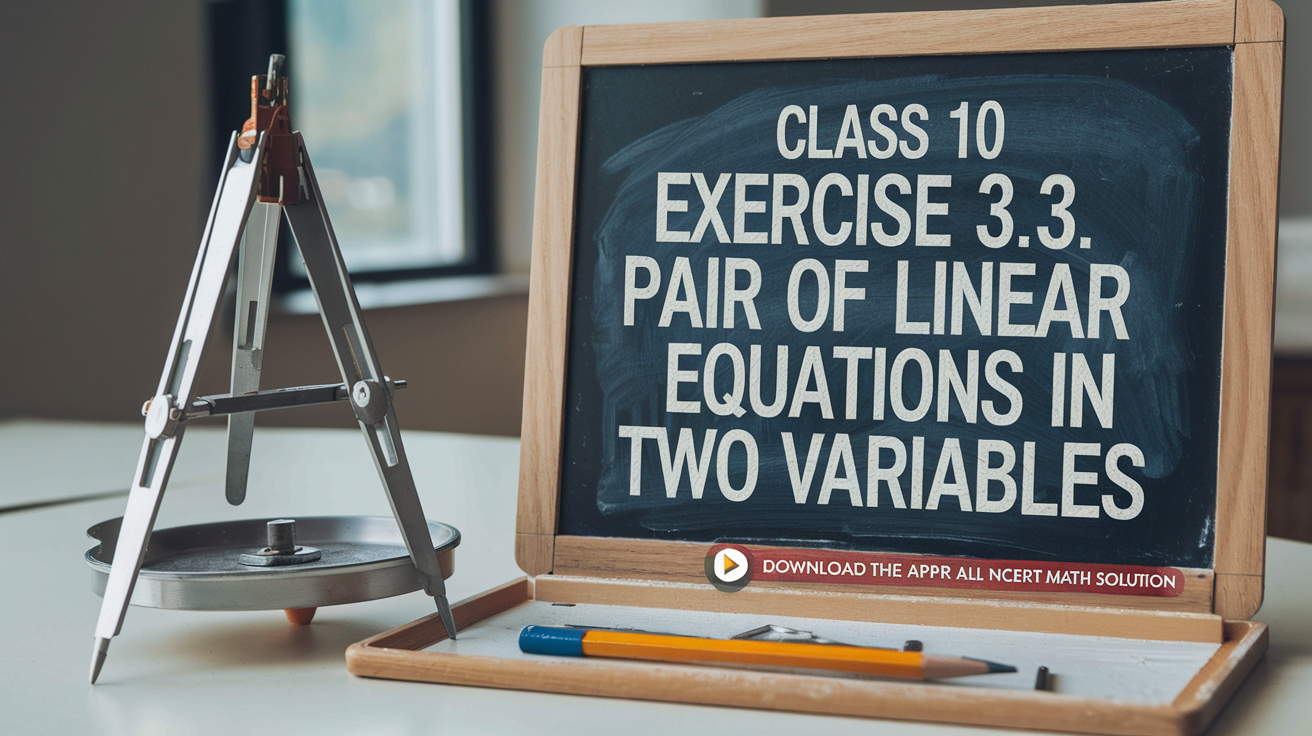
(vi) Solve the following pair of linear equations by the substitution method.
\( \frac{3 x}{2}-\frac{5 y}{2}=-2 \)
\( \frac{x}{3}+\frac{y}{2}=\frac{13}{6}\)
\( \frac{3 x}{2}-\frac{5 y}{2}=-2 \)
\( \frac{x}{3}+\frac{y}{2}=\frac{13}{6}\)
Answer
\( \frac{3 x}{2}-\frac{5 y}{3}=-2 \ldots(i)\)and
\( \frac{x}{3}+\frac{y}{2}=\frac{13}{6} \ldots(ii)\)
From equation (i) we get,
By taking L.C.M and solving we get,
\( \frac{3 \times 3 x-2 \times 5 y}{6}=-2 \)
\(9 \mathrm{x}-10 \mathrm{y}=-12\)
\(x=\frac{-12+10 y}{9}\)
Putting this value of \( x \) in equation (ii), we get,
\(\Rightarrow \frac{\frac{-12+10 y}{9}}{3}+\frac{y}{2}=\frac{13}{6}\)
\(\Rightarrow \frac{-12+10 y}{27}+\frac{y}{2}=\frac{13}{6}\)
\(\Rightarrow 47 \mathrm{y}=117+24\)
\(\Rightarrow 47 \mathrm{y}=141\)
\(\Rightarrow \mathrm{y}=\frac{141}{47}=3\)
Putting value of \( y \) in (iii)
\(\Rightarrow x=\frac{-12+10 y}{9}=\frac{-12+10 \times 3}{9}=\frac{18}{9}=2\)
Hence, \( x=2 \) and \( y=3 \)
2. Solve \( 2 x+3 y=11 \) and \( 2 x-4 y=-24 \) and hence find the value of ' m ' for which \( \mathrm{y}=\mathrm{mx}+\mathrm{x} \).
Answer
To Solve: \( 2 \mathrm{x}+3 \mathrm{y}=11 \ldots(i)\) \(2 x-4 y=-24 \ldots(ii)\)
Solving by substitution method,
From equation (i)
\(2 x=11-3 y \ldots(iii)\)
putting value of \(2 x\) from equation (iii) to equation (ii)
\((11-3 y)-4 y=-24\)
\(\Rightarrow 11-7 y=-24\)
\(\Rightarrow-7 y=-35\)
\(y=\frac{-35}{-7}\)
\(y=5\)
Putting value of \( y \) in equation (iii) we get,
\(2 \mathrm{x}=11-3 \times 5=11-15=-4\)
\(\mathrm{x}=-\frac{4}{2}=-2\)
Now, putting values of \(x\) and \(y\) in equation
\(y=m x+3\)
\(5=-2 m+3\)
\(=-2 m=2\)
\(m=-\frac{2}{2}=-1\)
Value of \( m \) is -1
NCERT Solutions for Class 10 Maths Chapter 3: Pair of Linear Equations in Two Variables || CBSE Class 10 Maths Chapter 3 Pair of Linear Equations in Two Variables solutions Ex 3.3 Math Solution
Download the Math Ninja App Now Ninja App3. Form the pair of linear equations for the following problems and find their solution by substitution method.
(i) The difference between two numbers is 26 and one number is three times the other. Find them.
Answer
i) Let larger number \( =\mathrm{x} \)Let smaller number \( =\mathrm{y} \)
According to the question,
\(=x-y=26\)
\(=x=26+y \ldots(i)\)
And,
\(=x=3 y \ldots(ii)\)
Comparing values of \(x\) from both equation, we get,
\(26+y=3 y\)
\(-2 y=-26\)
\(y=13\)
So, \( x=3 y=3 \times 13=39 \)
Hence, the numbers are 13 and 39.
(ii) The larger of two supplementary angles exceeds the smaller by 18 degrees. Find them.
Answer
Let the first angle \( =x \)Let second angle \( =y \)
According to the question,
\( =x+y=180 \) (sum of supplementary angles is always 180)
\(\mathrm{x}=180-\mathrm{y} \ldots(i)\)
And,
\(=x-y=18 \ldots(ii)\) Given
Putting value of \( x \) from equation (i) to (ii). we get,
\(=180-y-y=18\)
\(=-2 y=18-180=-162\)
\(=y=\frac{-162}{-2}=81\)
\(\text { so, } x=180=y=180-81=99\)
Hence the angles are \( 99^{\circ} \) and \( 81^{\circ} \)
NCERT Math Solutions for Class 10 Maths Chapter 3 Pair of Linear Equations in Two Variables solutions (English Medium) || CBSE Class 10 Maths Chapter 3 Pair of Linear Equations in Two Variables Ex 3.3 Math Solution
Download the Math Ninja App Now(iii) The coach of a cricket team buys 7 bats and 6 balls for Rs 3800 . Later, she buys 3 bats and 5 balls for Rs 1750 . Find the cost of each bat and each ball.
Answer
Let cost of each bat \( = \) Rs. XLet cost of each ball \( = \) Rs. \( Y \)
According to the question,
\(=7 x+6 y=3800 \text { Given }\)
\(=6 y=3800-7 x\)
\(=y=\frac{3800-7 x}{6} \ldots(i)\)
And
\(=3 x+5 y=1750 \ldots(ii) \) Given
Putting value of \(y\) from Equation (i) to equation (ii)
\(=3 x+5 \times \frac{3800-7 x}{6}=1750\)
\(=18 \mathrm{x}+1900-35 \mathrm{x}=1750 \times 6\)
\(=-17 x=10500-19000=-8500\)
\(=x=\frac{-8500}{-17}=500\)
Putting value of \( x \) in equation (i), we get
\(=y=\frac{3800-7 \times 500}{6}=\frac{300}{6}=50\)
Hence,
Cost of each bat \( = \) Rs. 500 and Cost of each ball \( = \) Rs. 50
(iv) The taxi charges in a city consist of a fixed charge together with the charge for the distance covered. For a distance of 10 km , the charge paid is Rs 105 and for a journey of 15 km , the charge paid is Rs 155 . What are the fixed charges and the charge per km? How much does a person have to pay for travelling a distance of 25 km ?
Answer
Let the fixed charge for taxi \( = \) Rs. XLet variable cost per \( \mathrm{km}= \) Rs. y
We know that,
Total cost \( = \) Fixed charge + Variable Charge
According to the question,
\(=x+10 y=105 \text { given }\)
\(=x=105-10 y \ldots(i)\)
And, For a journey of 15 km charge paid = Rs. 155
\(\text { so, } x+15 y=155 \ldots(ii)\)
Putting value of \( x \) from equation (i) to equation (ii). we get,
\(=105-10 y+15 y=155\)
\(=5 y=155-105=50\)
\(y=\frac{50}{5}=10\)
Putting value of \( y \) in equation (i). we get,
\(=x=105-10 \times 10=105-100=5\)
So, People have to pay for travelling a distance of 25 km
\(=x+25 y=5+25 \times 10=\text { Rs. } 255\)
(v) A fraction becomes \( \frac{9}{11} \) if 2 is added to both the numerator and the denominator. If, 3 is added to both the numerator and the denominator it becomes \( \frac{5}{6} \). Find the fraction.
Answer
Let numerator \( =x \)Let denominator \( =\mathrm{y} \)
Fraction will be \( =\frac{x}{y} \)
According to the question,
Fraction become \( \frac{9}{11} \), if 2 is added in both. Numerator and denominator
\(=\frac{x+2}{y+2}=\frac{9}{11}\)
\(=11 \mathrm{x}+22=9 \mathrm{y}+18 \text { (by cross multiplication) }\)
\(=11 \mathrm{x}=9 \mathrm{y}-4\)
\(=x=\frac{9 y-4}{11} \ldots(i)\)
And, if 3 is added to both numerator and denominator it become \( \frac{5}{6} \)
\(=\frac{x+3}{y+3}=\frac{5}{6}\)
\( =6 x+18=5 y+15 \ldots(ii)\) By cross multiplication
Putting value of \( x \) from equation (i) to equation (ii)
\(=6 \times \frac{9 y-4}{11}+18=5 y+15\)
\(=54 y-24=55 y-33\)
\(=-y=-9\)
\(=y=9\)
Putting value of \( y \) in equation (i)
\(=x=\frac{9 y-4}{11}=\frac{9 \times 9-4}{11}=\frac{77}{11}=7\)
Hence, the fraction is \( \frac{7}{9} \).
(vi) Five years hence, the age of Jacob will be three times that of his son. Five years ago, Jacob's age was seven times that of his son. What are their present ages?
Answer
Let present age of Jacob \( =X \) yearsLet present age of his son \( = \) Y years
Five year hence,
Age of Jacob \( =X+5 \)
Age of son \( =Y+5 \)
And, age of Jacob is 3 times of his son Given
\(=x+5=3(y+5)\)
\(=x+5=3 y+15\)
\(=x=3 y+10 \ldots(i)\)
Five years ago,
Age of Jacob \( =\mathrm{X}-5 \)
Age of son \( = \) Y - 5
And, Jacob's age was 7 times of his son Given
\(=x-5=7(y-5)\)
\(=x-5=7 y-35\)
\(=x-7 y=-30 \ldots(ii)\)
Putting value of X from equation (i) to equation (ii)
\(=3 y+10-7 y=-30\)
\(=-4 y=-40\)
\(=y=\frac{-40}{-4}=10\)
Putting value of \( Y \) in (i)
\(=x=3 \times 10+10=30+10=40\)
Hence, present age of Jacob \( =40 \) years and his son's age \( =10 \) years.
NCERT Math Solutions for Class 10 Maths Chapter 3 Pair of Linear Equations in Two Variables solutions (English Medium) || CBSE Class 10 Maths Chapter 3 Pair of Linear Equations in Two Variables Ex 3.3 Math Solution
Download the Math Ninja App NowCentral Board of Secondary Education Official Site
Class 10 : NCERT Solutions for Class 10 Maths Chapter 1 Exercise 1.1
Class 10 : NCERT Solutions for Class 10 Maths Chapter 1 Exercise 1.2
Class 10 : NCERT Solutions for Class 10 Maths Chapter 1 Exercise 1.3
Class 10 : CBSE Class 10 Maths Chapter 2 Polynomials Ex 2.1
Class 10 : CBSE Class 10 Maths Chapter 2 Polynomials Ex 2.2
Class 10 : CBSE Class 10 Maths Chapter 2 Polynomials Ex 2.4
Class 10 : CBSE Class 10 Maths Chapter 3 Pair of Linear Equations in Two Variables Ex 3.1
Class 10 : CBSE Class 10 Maths Chapter 5 Arithmetic Progressions Ex 5.3
Class 10 : NCERT Solutions for Class 10 Maths Chapter 8 Exercise 8.2
Class 10 : CBSE Class 10 Maths Chapter 10 Circles solutions Ex 10.2
Class 10 : CBSE Class 10 Maths Chapter 13 Surface Areas and Volumes solutions Ex 13.2

